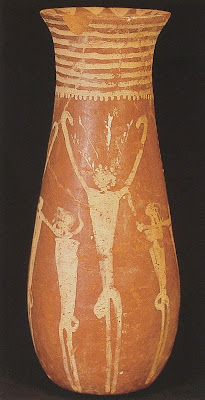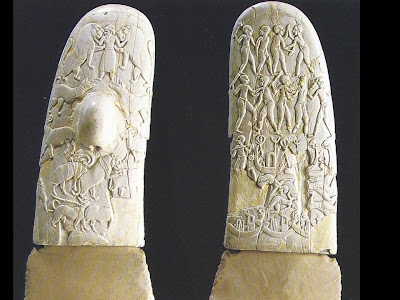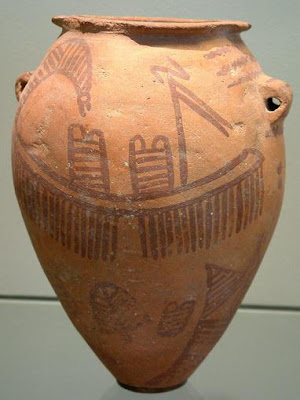Naqada I
is a city located in Qena where a huge number of potteries were found in
more than 900 tombs. More than 1500 tombs had been discovered up till
now.
The
culture of Naqada I is distinguished with smooth red pottery,
black-edged red pottery and a third kind of pottery with white
paintings. Pottery at this phase had various shapes. People used it in
making bowls, pots, plates and cups.
Tombs
of Naqada I resembled oval holes, where the dead person was to be
buried in fetus position and directed to the south. Dead people's
corpses were wrapped with goatskin or mat and there were mass graves as
well.
These
tombs suggest that either they were family graves or that the servants
of the dead were killed and buried to serve their masters in the Second
Life. Also discovered are tombs for animals and humans buried together.
 |
| Naqada I |
 |
| Naqada I |
Naqada II
Naqada II
culture is extends to Lower Nubia area on the south; there are not
discoveries of Naqada II's ancient monuments in Delta.
The
Ancient Egyptians used diorite, basalt and Alolpastr for making stony
vessels. Also, they used green slate for making bird-like, fish-like and
turtle-like vases. In addition, they made rectangle vases with their
edges decorated shapes of birds and animal heads.
The
cemetery in Naqada II is like a square or a rectangle. The Egyptians
tried to outline the interior boundaries of cemetery by using mud then
by ditch reeds or boards. The dead person was buried in fetus position
and shrouded in flax.
 |
| Naqada II |
Naqada III
Naqada III is the last phase of period of ancient Egyptian prehistory, from 3200 to 3000 BC.
It
is the period during which the process of state formation, which had
begun to take place in Naqada II, Naqada III extends all over Egypt.
 |
| Naqada III |
 |
| Naqada III |








Comments
Post a Comment